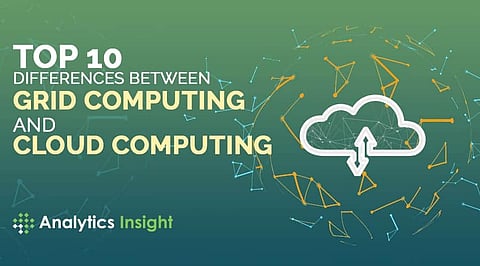

The availability of a wide range of computing resource options makes users easily lost in the shuffle. Currently, grid computing and cloud computing are among some of the famous buzzwords in the industry, and both have their advantages and use cases. Mainly, both cloud computing and grid computing are used to process tasks. However, grid computing is used in cloud computing but it is not a cloud or part of it. They both involve massive computer infrastructures and managing them. Both cloud computing and grid computing concepts have been developed for distributed computing, that is, computing an element over a large area, literally on computers that are separated by some of the other means. The main differences are listed below.
Grid computing consists of a large number of computers that are connected parallel and form a computer cluster. This combination of connected computers is used to solve a complex problem. In grid computing, this service of the computer is connected and runs independent tasks. We often construct these grades with general-purpose grade middleware software libraries.
Cloud computing is nothing but the delivery of computing services such as a database, networking, software, storage, servers, and many more. Nowadays the companies need some virtual space to store the data which generates. So, cloud computing provides this facility which is flexible, user-friendly, with compatibility issues. It helps to run the infrastructure efficiently and integrate the business very quickly.
In grid computing, the management assets are decentralized and it has virtual organization-based management. On the other hand, the resources in cloud computing are centrally managed as the whole cloud can work with the centralized system or it can be delegated to any third party.
It is easy in the cloud to backup and restore the data as it has fast data processors. The new updates in cloud computing are efficient and automatic. In a grid, computing space is saved and access to additional resources can be done.
Grid computing is based on a distributed system which means computing resources are distributed among different computing units which are located across different sites, countries, and continents. In cloud computing, computing resources are managed centrally which are located over multiple servers in clusters in cloud providers' private data centers.
The applications that expand on the cloud are business explicit applications, for example, online applications regularly utilized by meagre customers or for handheld gadgets. On the other hand, Grid centres around the research-based application with the assistance of distributed independent administrative units working inside and out for taking care of a bigger figuring issue
One of the main differences between grid computing and cloud computing is the prices required. In general, there is no defined business model in grid computing. As against, the cloud users have to pay as they use. This refers to the utility pricing or metered billing where users do not have to pay as they release the resources.
Grid computing uses all kinds of computing resources for job scheduling. In grid big tasks are divided into multiple tasks which can be solved by multiple computers as the work is assigned to a particular computer. Cloud computing has resources that are pooled through grouping resources and requires the basis from the cluster of servers.
In grid computing, assets and resources are circulated over grids, though in cloud computing, assets are overseen midway. Cloud computing ousts the need of purchasing the programming software and hardware which requires complex design and exorbitant upkeep for building and sending applications rather it conveys it as assistance or as a service over the web.
Grid computing is a form of computing that follows a distributed architecture which means a single task is broken down into several smaller tasks through a distributed system involving multiple computer networks. Cloud computing, on the other hand, is a whole new class of computing based on network technology where every user of the cloud has its private resource that is provided by the specific service provider.
Cloud computing is an emerging technology and is a descendant of grid computing. Cloud computing provides real-time user-friendly services on a dedicated, high bandwidth internet connection and unlimited resources but its main disadvantage is that it needs a high-speed internet connection. Grids are heterogeneous, loosely coupled and geographically distributed, and better than traditional clusters. Although security could be a major issue while using grid computing.
Join our WhatsApp Channel to get the latest news, exclusives and videos on WhatsApp
_____________
Disclaimer: Analytics Insight does not provide financial advice or guidance. Also note that the cryptocurrencies mentioned/listed on the website could potentially be scams, i.e. designed to induce you to invest financial resources that may be lost forever and not be recoverable once investments are made. You are responsible for conducting your own research (DYOR) before making any investments. Read more here.
